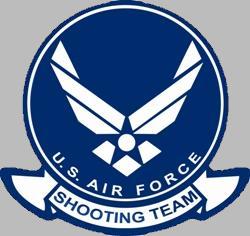
Highlights in History for the USAF Competitive Shooting Teams

 |
Highlights in History for the USAF Competitive Shooting Teams |
 |
Information on this and other pages dealing with the history of the Team has been gathered from many sources to include awards pages of the NRA and CMP, bulletins from Interservice and other matches and articles written by former members. Two articles of note are "Sharpshooters from the Wild Blue Yonder" by Mr. Charles E. Petty which appeared in the January 1985 American Rifleman magazine and Outline History of the United States Air Force Marksmanship School by TSgt Arnold Vitarbo USAF (Ret).
I would like to thank the following individuals for their continuing support in helping to fill in the pages of our history: Mr. Charles E. Petty, SMSgt Donald R. Rupp (USAF Ret), SMSgt Hugo Legg (USAF Ret), SMSgt Thomas Hardgrave (USAF Ret), TSgt Arnold Vitarbo (USAF Ret).
Special Note: The Photo Scrapbook pages have been transferred to the Team's Gallery pages. Please visit our History, Scrapbook and Miscellaneous album. Anyone with any items to add to our collection (pictures, bulletins, etc.) is encouraged to contact Edwin Hall (USAF Ret).
Second Note: Although not associated with either the USAF or its shooting teams, there is an Association of USAF shooters which includes those who supported the Teams and those involved in the Marksmanship career field. For more information see USAF Shooters Association.
The USAF competitive shooting teams at Lackland AFB were very active from early 1958 until July 1969, when they were disbanded. During that time, the Air Force had a full time shooting program for several disciplines. Many of the early competitors represented not only the Air Force, but the nation, at events such as the 1964 Olympics, where Capt Franklin Green won a silver medal.
For at least the years 1971-1973, the Air Force conducted matches starting at the base level and working up to building a team for competition at the National Matches. The competitors came from career fields across the spectrum of the Air Force instead of from a centralized team. An airman vying for a spot on what could be called a pick-up team, would enter a base competition, often as a member of an organization's team. A top percentage of the competitors would then be sent on to the Major Command level where members from several bases would compete. The top competitors from those matches would then meet at the All Air Force Matches held at Lackland Air Force Base, TX. From there a team was selected to represent the Air Force at the National Matches held at Camp Perry, OH. The top firing airman in the All Air Force Matches was named, "USAF Champion" for their respective discipline
In the years to follow, a few airmen still competed individually at varying levels, but were not supported by the Air Force. In more recent times, the Air Force has again begun to support the competitive shooting members in a manner commensurate with the other sports programs. The current National Teams are composed of airmen who have other duties as their primary mission and are allowed to compete as time permits. Most of the effort put forth by these members comes from personal resources.
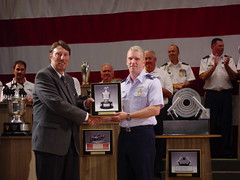 1955 - Col Thomas C. Kelly
1955 - Col Thomas C. Kelly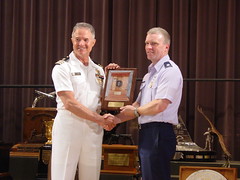 1992 - Col Robert Engelmeier
1992 - Col Robert Engelmeier 1961 - Capt Franklin C. Green
1961 - Capt Franklin C. Green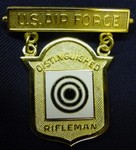
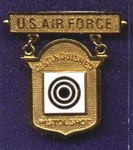
The Air Force, like the other services, manages its own program for awarding Distinguished Badges to airmen who qualify. The program is run in full cooperation with the CMP. When an airman qualifies for distinguished points in a CMP match, the CMP forwards that information to the Air Force where it is evaluated and points are awarded. Unlike civilians who receive 10 points for any award at Camp Perry, when an airman receives points from Camp Perry, these reflect the level of the award (10, 8 and 6 points for Gold, Silver and Bronze, respectively).
The first airman to receive the US Air Force Distinguished Pistol Shot Badge (number 001) was Col Thomas Kelly. This was quite appropriate, since it was he who had been tasked by General LeMay to build a shooting program within the Air Force structure. He had been chosen in part, because he was already an accomplished shooter (he won the Twining Trophy in both 1955 and 1956), and had created a base team which had done well locally.
Special Note: As of 2007, the CMP has begun adding the Air Force Distinguished recipients to its databases. Unfortunately, there appear to be no records of issue dates and addresses for the individuals. The CMP has issued a request for this information from those who have become Distinguished over the years. For more details see the CMP Request on the news page.
